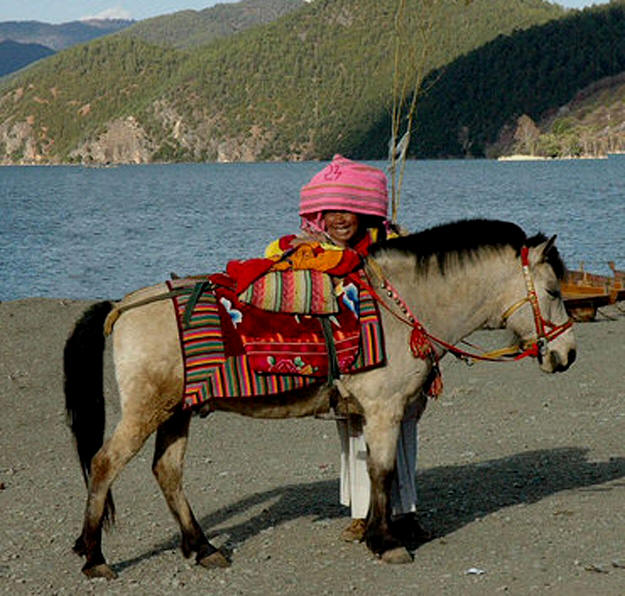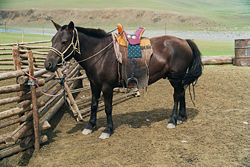Mongolian Horse, Mori or Mor'

3-D Flags
Country of Origin: Mongolia
The Mongolian horse is the native horse breed of Mongolia. The breed is purported to be largely unchanged since the time of Genghis Khan. Nomads living in the traditional Mongol fashion still hold more than 3 million animals, which outnumber the country's human population. Despite their small size, they are horses, not ponies.
In Mongolia, the horses live outdoors all year (at 30°C in summer down to -40°C in winter) and search for food on their own. The mare's milk is processed into the national beverage Airag, and some animals are slaughtered for meat. Other than that, they serve as riding animals, both for the daily work of the nomads and in horse racing.
Characteristics
Mongolian horses are of a stocky build, with relatively short legs and a large head. They range in size from 12 to 14 hands high and have a cannon diameter of about 8 inches. They have a certain resemblance to Przewalski's Horse. The mane and tail are very long, and the strands are often used for braiding ropes; the tail hair can be used for violin bows. The hooves are very robust, and very few animals are fitted with horseshoes.
Behavior
Mongolian horses are frugal, arduous, somewhat wily, and tread safely in rough terrain. In Mongolia, most animals are kept roaming free, and only a small number of riding animals get caught and tethered. Once the animal has become familiarized with carrying a rider, it will be calm, friendly, and very reliable.
The Mongolian saddle is very tall, with a wooden frame. It only allows marginal control of the gait. In most situations, the horse will decide the gait on its own, while the rider is occupied with other tasks (such as herding cattle). Very often, a Mongolian horse will choose to canter.
Child Racing at the Naadam Festival - Racing horses with a child in the saddle will run in full gallop over 35 km at a time. They are trained to keep running even after losing their riders. In such a case, they need to be stopped in the finish zone by aides waiting there especially for that purpose.
Breeding History
The exact origins of the breed are hard to determine. Horseback riding has been documented with the nomads of the central Asian steppes since 2000 BC. Tests have shown, that among all horse breeds, Mongolian horses feature the largest genetic variety, followed by the tuwinian horses. This indicates that it is a very archaic breed suffering little human induced selection. The data also indicate that many other breeds descend from the Mongolian horses.
Horses in Mongolian Culture
Horses are greatly cherished in Mongolian culture, particularly among the nomads because horses are very useful to people's daily lives and livelihood. A nomad with many horses is considered wealthy, and having many horses which are also in good shape is considered honorable behavior. Mongols almost never kill their horses for food unless they are in a state of extreme hunger and cattle or sheep are not available. Mongol people individually have favorite horses, each family member has his and her own horse, and some family members value their favorite horses by saving them from working under a lot of pressure.
The Mongolian Horse in Art
The Mongolian Horse was the subject of various works by the English painter Vincent Haddelsey, who undertook a trip to Inner Mongolia in 1980, to study and paint this animal.
For More Information:
Biogenetics Research Large File
Oklahoma State University Breeds of Livestock
Mongolian Horse Population
| 
